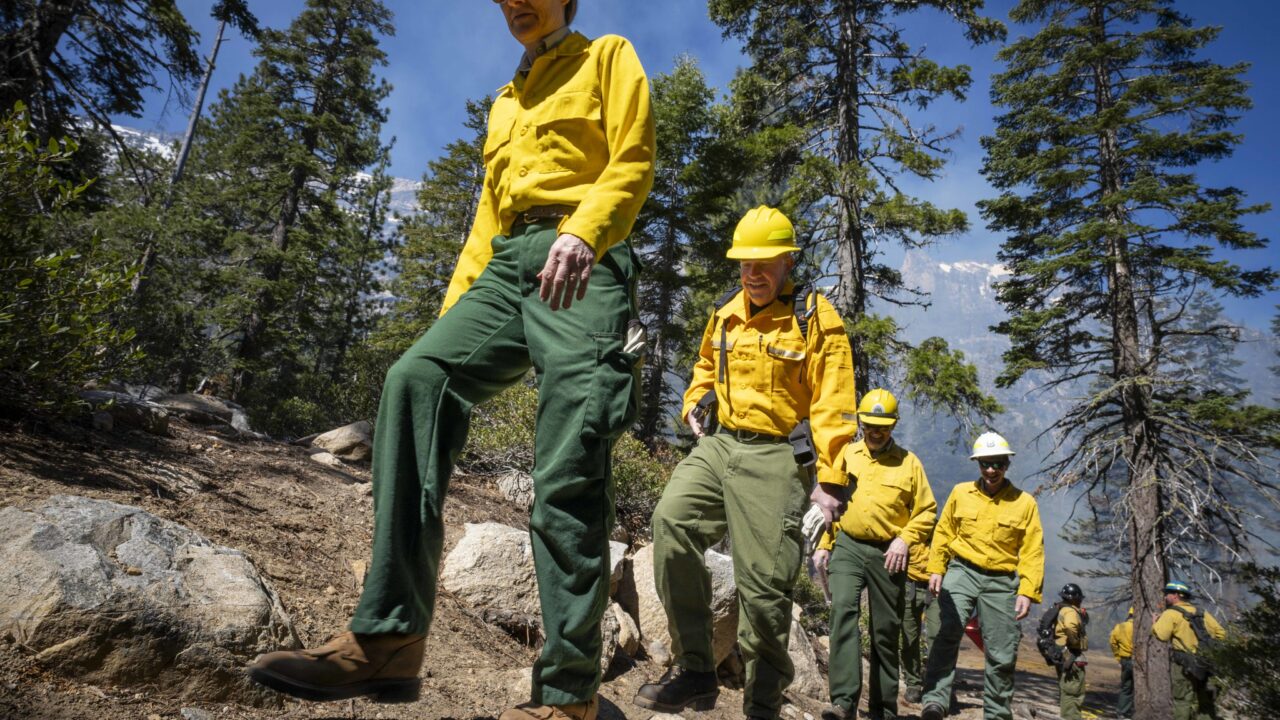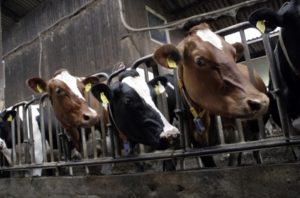As Trump Comes After Research, Forest Service Scientists Keep Working
Scientists describe how they’re preparing for the upcoming field season despite new political challenges. A Forest Service team visits a prescribed burn at Lake Tahoe Basin Management Unit on May 7, 2025. (USDA Forest Service photo by Preston Keres)
A Forest Service team visits a prescribed burn at Lake Tahoe Basin Management Unit on May 7, 2025. (USDA Forest Service photo by Preston Keres)
This story was originally published by High Country News.
The research and development team at the U.S. Forest Service employs about 1,500 people full-time, a small but mighty faction inside an agency that, until recently, was 35,000 strong. The research it conducts spans such varied issues as managing visitors at recreation hotspots to understanding the pulse of life and land on the 193 million acres the agency manages.
Since President Donald Trump took office, his barrage of executive actions in the name of curbing waste have imperiled the basic functions of federal agencies. At the Forest Service, the result is a climate of fear and uncertainty that’s stymieing the scientists working to fulfill the agency’s mission — sustaining the nation’s forests and grasslands for the public’s long-term benefit — just as the summer research field season ramps up.
“Science and research are critical to maintaining public lands,” said Jennifer Jones, the program director of the Center for Science and Democracy at the nonprofit Union of Concerned Scientists. Federal scientists intimately understand the ecosystems of the public lands they study. Their institutional position and on-the-ground knowledge make them uniquely suited to translate study findings into effective management. “If we lose a few months — a few years — of science and science-led management of those natural resources, it could take decades and generations for ecosystems to recover if they’re poorly managed,” she said.
“Science and research are critical to maintaining public lands.”
Forest Service workers describe the last few months as an emotional roller coaster. First came the freezes of congressionally approved spending, followed by confusing resignation offers for federal employees, firings that were reversed almost as quickly as they were ordered and promises of further workforce culling through planned downsizing. The Trump administration has even called for eliminating Forest Service research stations, according to reporting by Government Executive; three of the five stations are located in the West.
Spring and summer are usually an all-hands-on-deck time of year for field-going scientists. As the snow melts and the days lengthen, researchers head outdoors for fieldwork they’ve been planning for all winter. This year, however, they are grappling with uncertainty regarding funding, labor and logistics. “I don’t know what I’m going to do on Day 1,” said a Forest Service aquatic biologist, who requested anonymity, citing fear of retribution for speaking publicly, just four weeks before their field season was set to begin. “I wish I had a plan. I just show up every day and see if there’s any news.”
Most of the planned field projects in that scientist’s district have been suspended indefinitely. Still, one study, with the Fish and Wildlife Service, may happen: a survey of the movement of threatened bull trout along a western Montana river. The goal is to see how local populations are faring so that future recovery efforts can target problem sites.
But whether the team can execute it is another matter. The biologist needs a minimum of two extra hands to help install fish traps and tag captured trout, and at least $10,000 to install transponders for tracking the fish. But that support is now uncertain, so the biologist is making contingency plans, building their own fish traps and calling in favors to see if other groups can help with personnel or equipment. “We’ll have to get really creative — and beg and borrow from other agencies,” they said. In theory, the project could be delayed until next year, but the team is acutely aware of the ticking clock of the trout’s survival. “The sooner you intervene, the better your results,” the biologist said.
Research also helps federal agencies cultivate community relationships. One Forest Service scientist leading an effort to map aquatic biodiversity across the West is hounded by job insecurity: If they lose their job, no one will be left to analyze and interpret the two years’ worth of field samples that state and tribal collaborators have already gathered. “When I can’t be accountable to my partners in holding up my end of the research, that doesn’t have a good look,” said the researcher, who requested anonymity because they weren’t authorized to speak publicly about their work. At the time of the interview, the scientist had no Plan B to salvage the project if they’re let go.
“Years and years that people have spent protecting things are about to go down the tubes.”
Forest Service research often involves repetitive environmental monitoring and inventorying. That allows scientists to catch anomalies, such as the initial appearance of an invasive species. The eradication of the invasive European grapevine moth from California’s wine country in 2016, for example, was due to early detection and rapid action. Still, it took federal and local agencies seven years to eliminate the berry-munching pest.
“If you just stop a program in the middle, that’s insane,” said Elaine Leslie, a former agency chief for biological resources at the National Park Service who is currently on the executive council of the Coalition to Protect America’s National Parks. “That is waste and fraud, right there. Years and years that people have spent protecting things are about to go down the tubes.”
In response to an email from High Country News asking about federal cuts to science, a spokesperson for the U.S. Department of Agriculture, which houses the Forest Service, sent a general statement that did not address concerns about what the changes mean for research. Instead, it read in part, “We have a solemn responsibility to be good stewards of Americans’ hard-earned taxpayer dollars and to ensure that every dollar is being spent as effectively as possible to serve the people.”
* * *
Other agencies are also under assault. The Trump administration has proposed dissolving the research divisions of the National Oceanic and Atmospheric Administration and the Environmental Protection Agency, as well as slashing NASA’s research budget. Some remaining scientists are taking on non-research duties: With a hiring freeze for seasonal custodians in place at Yosemite National Park, scientists are on the roster for cleaning toilets.
All this translates to a chaotic period for agency employees. Delays and uncertainty are eating into the valuable hours of the limited field season. Getting field-ready takes time: hiring seasonal staff, training new recruits, setting fieldwork schedules and ensuring that everyone is paperwork-compliant. “From A to Z, there’s a lot to do before you ever put a boot in the field,” Leslie said. “Everybody’s behind because of this debacle.”
At first glance, the science at the Forest Service — including studies on the foraging behavior of fish, the rhythms of coastal fog and the properties of river bedrock — might seem esoteric. But scientific breakthroughs often occur only after years of investment, when scientists finally put together enough pieces to reach a larger understanding.
“You never know where the leaps and bounds are going to come from,” said the aquatic biologist researching bull trout. So, field season after field season, “you just have to keep looking.”
Dig, Root, GrowThis year, we’re all on shaky ground, and the need for independent journalism has never been greater. A new administration is openly attacking free press — and the stakes couldn’t be higher.
Your support is more than a donation. It helps us dig deeper into hidden truths, root out corruption and misinformation, and grow an informed, resilient community.
Independent journalism like Truthdig doesn't just report the news — it helps cultivate a better future.
Your tax-deductible gift powers fearless reporting and uncompromising analysis. Together, we can protect democracy and expose the stories that must be told.
This spring, stand with our journalists.
Dig. Root. Grow. Cultivate a better future.
Donate today.






You need to be a supporter to comment.
There are currently no responses to this article.
Be the first to respond.